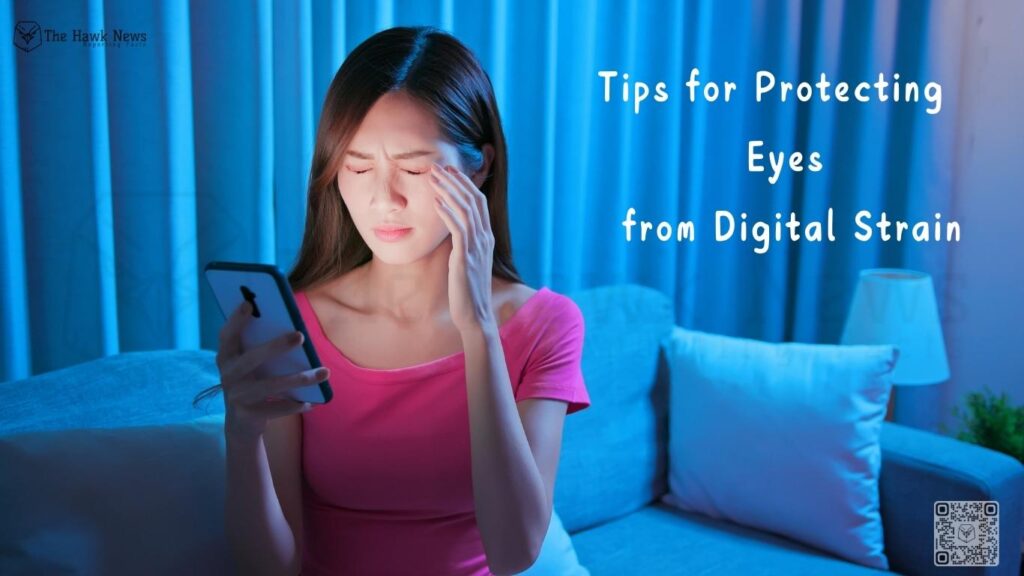
In today’s digital age, screens are an integral part of our daily lives. Whether it’s for work, education, or entertainment, we often find ourselves glued to computers, tablets, and smartphones for hours on end.
While these devices offer numerous benefits, they also pose significant risks to our eye health. Prolonged screen time can lead to digital eye strain, a condition that affects millions of people worldwide.
This article explores the impact of excessive screen use on eye health, identifies common symptoms of digital eye strain, and provides practical tips to help protect your eyes in our screen-dominated world.
Understanding Digital Eye Strain
Digital eye strain, also known as computer vision syndrome (CVS), encompasses a range of eye and vision-related problems resulting from prolonged screen use. The American Optometric Association reports that nearly 60% of people who work on computers experience symptoms related to digital eye strain.
Symptoms of Digital Eye Strain
The symptoms of digital eye strain can vary from person to person but commonly include:
- Dry Eyes: Staring at screens often leads to reduced blinking, causing dryness and irritation.
- Eye Fatigue: Extended focus on screens can lead to tired eyes and discomfort.
- Blurred Vision: Difficulty in focusing can occur, particularly after long sessions of screen time.
- Headaches: Strain on the eye muscles can result in tension headaches.
- Neck and Shoulder Pain: Poor posture during screen use can lead to musculoskeletal discomfort.
These symptoms can be bothersome and affect overall productivity and quality of life. Understanding the risks is the first step toward prevention.
The Science Behind Digital Eye Strain
The primary factors contributing to digital eye strain include:
- Blue Light Exposure: Screens emit blue light, which can contribute to eye fatigue and discomfort. Although research on its long-term effects is ongoing, there are concerns that excessive exposure may disrupt sleep patterns and contribute to digital eye strain.
- Poor Posture: Improper ergonomics during screen use can lead to physical strain, affecting not just the eyes but the neck and shoulders as well.
- Environmental Factors: Glare from screens, poor lighting conditions, and the distance between the eyes and the screen can all exacerbate eye strain.
Tips for Reducing Digital Eye Strain
To combat the effects of prolonged screen time, consider implementing the following strategies:
1. The 20-20-20 Rule
One of the simplest and most effective strategies for reducing digital eye strain is the 20-20-20 rule:
- Every 20 minutes, take a break from your screen.
- Focus on an object 20 feet away for at least 20 seconds.
This practice helps to relax the eye muscles and encourages blinking, which alleviates dryness.
2. Optimize Your Workspace
Creating an ergonomic workspace can significantly reduce strain on your eyes and body. Consider the following adjustments:
- Screen Position: Position your screen about an arm’s length away and slightly below eye level. This encourages a natural head and neck posture.
- Chair Height: Use a chair that allows your feet to rest flat on the floor, supporting good posture.
- Lighting: Ensure your workspace is well-lit. Avoid working in dim light or with harsh overhead lights, as both can increase glare and strain.
3. Adjust Display Settings
Tweaking your device settings can make a considerable difference in comfort:
- Brightness and Contrast: Adjust the brightness of your screen to match the ambient lighting. High contrast between text and background can also ease reading.
- Text Size and Font: Increase the text size for better readability and choose fonts that are easy on the eyes.
- Blue Light Filters: Consider using blue light filter software or screen protectors, especially in the evening. Many devices now have built-in night modes that reduce blue light emission.
4. Blink More Often
When focusing on screens, we tend to blink less frequently, leading to dry eyes. Consciously remind yourself to blink regularly to keep your eyes lubricated. You can also use lubricating eye drops if you experience persistent dryness.
5. Take Regular Breaks
In addition to the 20-20-20 rule, implement longer breaks throughout your work or study session. Every hour, step away from your screen for 5 to 10 minutes. Use this time to stretch, hydrate, or take a short walk.
6. Maintain a Healthy Diet
A balanced diet rich in nutrients that support eye health can help mitigate the effects of digital strain. Consider incorporating:
- Omega-3 Fatty Acids: Found in fish like salmon, omega-3s help maintain eye moisture.
- Leafy Greens: Foods like spinach and kale are high in lutein and zeaxanthin, antioxidants that protect the eyes from harmful light.
- Carrots and Sweet Potatoes: Rich in beta-carotene, these foods contribute to overall eye health.
The Role of Regular Eye Exams
Incorporating regular eye exams into your routine is crucial for maintaining eye health, especially if you spend significant time on screens. An eye care professional can assess your vision, recommend appropriate corrective lenses, and provide personalized advice on managing digital eye strain.
Conclusion: Prioritize Your Eye Health
As our reliance on digital devices continues to grow, protecting our eyes has never been more important. By understanding the risks associated with prolonged screen time and implementing practical strategies to reduce strain, you can safeguard your vision and maintain your overall well-being.
Embracing the 20-20-20 rule, optimizing your workspace, adjusting display settings, and being mindful of your eye health will go a long way in preventing digital eye strain. Additionally, maintaining a healthy diet and prioritizing regular eye exams will contribute to long-term eye health.
In a world that thrives on technology, taking proactive measures to protect your eyes is essential. By adopting these practices, you can enjoy the benefits of digital devices while keeping your vision clear and healthy for years to come. So, the next time you settle in for a long screen session, remember to prioritize your eye health—it’s a small effort that can lead to significant rewards.